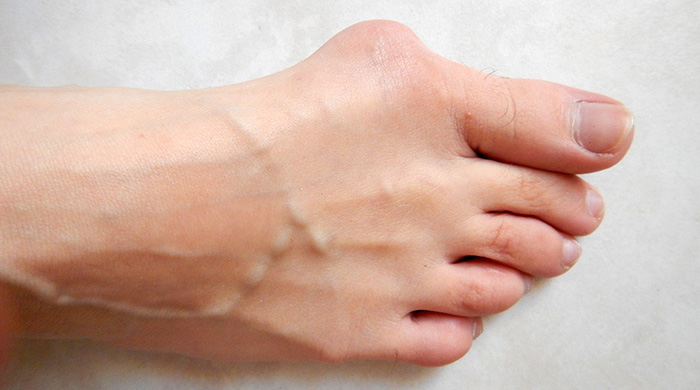Bunions
What are Bunions?
Also known as Hallux Abducto Valgus or HAV. A bunion is an enlargement of the big toe joint. It occurs when the big toe moves out of place.
Causes of Bunions
Bunions tend to be hereditary. People who are unusually flexible are more prone to developing them. They are also more common in women than men. Tight footwear and excessively high heels can play a part in causing the deformity, but usually this is in people who are at a higher risk of developing them anyway.
Bunion Symptoms
The main problem is pain over the bony prominence which can be exacerbated by tight fitting shoes. The joint can become red and inflamed and cause great discomfort when walking. Also, because the big toe is not working as well, the other toes have to work harder. This can cause pain in the ball of the foot, corns and calluses. The big toe can eventually push the second toe out of place so it also presses on footwear. This is called a Hammer Toe. Bunions are often accompanied by fallen arches or ‘0ver-pronation,’ so arch support in footwear helps. Another symptom can be ingrowing toenails caused by pressure of the big toe on the second toe. The big toe will eventually stiffen and arthritis can set in.
Treatment
People can have large bunions and have no symptoms or have relatively small bunions and be in considerable pain, and, not only around the big toe areas. Many people can be comfortable with just wearing wide fitting shoes whilst others may require some form of padding to relieve the pressure of footwear or orthotic insoles to help support the arch, ball of foot and/or realign the foot.
Before surgery is considered, there are more conservative methods of treatment to try, such as paddings, toe spreaders, orthotic insoles, orthotic footwear and night splints (more beneficial for children). I also recommend massaging/manipulation and ultrasound, which helps to relieve bunion pain and inflammation.
Exercises are important in keeping the joint mobile and flexible, strengthening the arches and helping reduce the risk of arthritis. (See below). Other treatments to consider are acupuncture and yoga. If these measures are not effective then surgery may be the only option.
Footwear Tips
Here are a few footwear tips to help your bunions.
- Only wear high heels for special occasions
- Keep the height below 2 inches with a wide heel
- If you want to wear high heels, why not have a lower pair to change into if it’s a long day?
- Never wear ballet pumps or flip flops, they are too thin, flat and unsupportive!
- Never walk on hard surfaces in bare feet
- Wellies and Ugg boots offer no support and damage the feet so don’t wear them for walking
- Orthotics and/or orthotic footwear will help (I stock Vionic and Strive footwear)
- Shoe stretchers can be used to stretch materials such as leather around the big toe joint, allowing for more room
- A bunion shield can protect the joint when wearing footwear to reduce pressure
- Always choose the right footwear for the job!
Finally, your G.P. or a foot specialist can advise on the best treatments for you. It is important to seek professional help for your personal footcare needs.
Bunion Exercises
- Use an elastic band and place it over both big toes. Keeping the ankles together, pull the feet apart and hold, then back to the centre again. Repeat this many times.
- Big toe press-ups. Stand or sit with your feet on a hard surface. Make sure your feet are parallel to your shoulders. Try and lift both big toes off the ground but leave the rest of your feet and toes firmly on the floor. Repeat often. This is difficult and takes a lot of practice.
- Grasp the big toe and try to “pull it off.” Hold for 10-15 seconds. Repeat.
- Grasp the big toe and rotate the joint in a clockwise direction, then an anti-clockwise direction. Repeat.
- With your heels on the ground, pick-up a towel with your toes. Repeat. This also strengthens arches.
- Use your toes to pick-up small objects such as marbles. This also strengthens arches
- Put an elastic band round all your toes and spread them apart. Repeat.
- Stretch your toes apart so they fan-out using toe spreaders or ‘yoga toes.’
I sell bunion shields, toe separators, orthotics for fashion shoes and orthotic footwear, by Vionic and Strive, including flip flops. These can be purchased online or from my clinics in Lymington (Hants) or from my mobile shop (Herts, Beds, Bucks).
I was delighted to be asked to be a guest blogger for The Natural Health Hub with this article.
